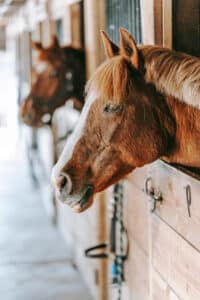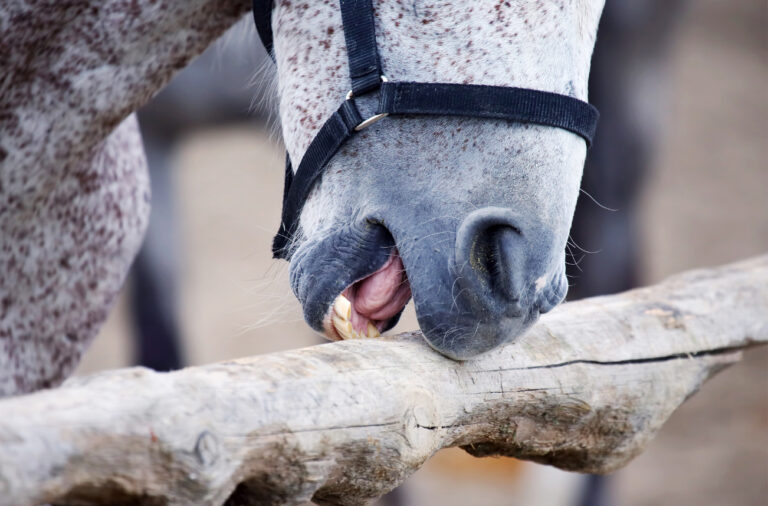If a horse is misbehaving, there’s likely to be a very good reason for it. DR JENNIFER STEWART looks at ‘bad’ behaviours and their causes.
The horse is a strange paradox of strength and acquiescence. They can overcome pain, injury, and the instinct for self-preservation to conform to the rider’s will. This represents a profound challenge for us all, and recognising that effective and humane training requires an understanding of the processes underlying your horse’s behaviour is paramount.
In recent surveys, up to 29% of leisure horse owners reported problem behaviour in their horses in relation to some aspect of management and stabling. Stabling and restriction of foraging time have been associated with the development of abnormal behaviours called stereotypies. Stereotypic behaviours are repetitive behaviours with no obvious function, such as cribbing, windsucking, weaving and box walking. These activities are found in approximately 10% of horses in captivity (stabled, confined) but have never been reported in free-roaming horses.
These behaviours are occasionally seen in horses kept in paddocks. Weaving over a field gate or cribbing on fence posts can occur in older horses who have been stabled and persevere with the behaviour in the paddock. Foals who received grain-based dietary supplements before weaning are more likely to crib-bite on fence posts and rails – supporting the relationship between diet and oral stereotypy found in older stabled horses.
Stabling and confinement
Over simplifying the definition of ‘normal’ behaviour risks some aspects of equine behaviour being labelled abnormal, when in fact they are normal, adaptive and have ensured the survival of horses for around 65 million years. Many behaviours considered undesirable are a result of domestication.

Confining horses imposes several stressors – restricted feeding and movement, isolation, reduced foraging and social contact. Weaving and box walking are associated with locomotor frustration; cribbing and windsucking, despite a properly formulated diet, with feeding management frustration. And all of these behaviours are related to distress.
For socially isolated/stabled horses, weaving can be significantly reduced with access to horses in adjacent stables. Mirrors can also help by reducing aggressive, threatening behaviour over the stable door. To reduce stress, provide non-toxic plants, branches and browse to encourage normal foraging, while constant access to roughage can also lessen boredom and stress. Hay nets should be placed near to, or on the ground. Nets placed any higher require the horse to raise their heads unnaturally high, predisposing them to respiratory conditions or infection due to the lessened ability of fine hairs and mucous in the windpipe to prevent dust and bacteria from reaching the lungs.
Pain
The possibility that horses are behaving badly because of pain must always be considered. Recognising early or subtle signs of pain is a challenge, but facial expression is a good indicator. The Horse Grimace Scale is an effective and practical method of identifying painful conditions (visit Equine Pain Face).
A recent survey of over 500 sport horses in normal work and presumed to be sound, found 47% were clearly lame. Early recognition of pain is an opportunity for early diagnosis and treatment, and can prevent problems progressing to the stage where the horse is experiencing reduced welfare, or a potentially dangerous situation occurs for the rider. Learning how to identify facial expressions, posture, gait changes and tail positions that indicate pain during riding can greatly reduce the horse’s (and the owner’s) stress.
An important milestone in equitation is the ethogram, a species-specific catalogue of all the observed behaviours of an animal and the social, environmental and other external factors that influence them. For our domestic horses (ridden or unridden), these external factors include management, training, and riding. The ethogram enables the detection of pain and is easy to use. Some good resources include the Equine Discomfort Ethogram, The Ridden Horse Pain Ethogram, and Recognising Pain in our Ridden Horses.
The quiet type
We depend on ‘reading’ our horse’s behaviour to understand what they’re feeling and experiencing, but it’s not always reliable. Horses cope with stress in different ways: proactive and reactive. Proactive or active copers try to get themselves out of the situation causing them stress, often by bucking, balking, rearing, biting, kicking, weaving or with any other negative expression of energy. Reactive or passive coping includes trying to adapt to the situation, by becoming still, stubborn, lazy or compliant – even when feeling fretful. Studies using body temperature, heart rate and eye temperature have found that horses that become still or quiet in worrying or demanding situations show the same stress responses in the body (Do Horses have a poker face?)
Puzzling behaviours
Yawning and playing are puzzling behaviours because in horses they can indicate stress. A large study of domestic horses kept in sub-optimal conditions (meal feeding with limited roughage availability and social isolation) found yawning is triggered by stress and emotional discomfort. Horses showing stereotypic behaviours yawn more than non-stereotypic horses. Based on this research, yawning and adult play can reflect altered welfare states. Other behaviours like licking, chewing, and head-lowering have long been equated with submission. Licking and chewing are behavioral indicators of the switch from sympathetic (fight, flight, freeze or fawn) to parasympathetic (rest and digest) nervous control and have recently been categorised as displacement and self-comforting activities in horses experiencing conflicting motivations, anxiety and adrenalin release.
Diet’s contribution
Feeding meals of concentrates reduces time spent foraging and chewing (free-range/wild horses chew around 57,600 times a day, hand-fed/domestic ones around 14,500). This leads to physical and psychological stress as reduced production of saliva diminishes the saliva buffer against gastro-intestinal acidity. Gastric acidity is the main cause of gastric ulcers and horses with ulcers – regardless of discipline – have elevated blood levels of the stress hormone cortisone. Straw bedding provides horses with one of their main mechanisms for regulating gut acidity. If adequate forage isn’t always available and horses are unable to, or prevented from, engaging in bedding-chewing, they develop compensatory activities such as cribbing and wood-chewing.

Australian and overseas studies have recently shown that a combination of magnesium and thiamine reduces speed reaction tests and fear responses measured by heart rate and cortisol. Because of its calming effects in humans, tryptophan has also been studied in horses – but the response is unpredictable. Rather than a sedative effect, oral tryptophan may (under both isolation and visual contact environments) stimulate 2 to 4 hours after dosing rather than having a sedative effect. There are also breed differences in response with Arabians and Standardbreds showing greater increases in heart rate and walking/sniffing activity after tryptophan administration.
Oils can have a calming effect on excitable horses, including weanlings and those prone to tying-up. Reactions to loud noise and visual stimuli are reduced in horses on 10% oil diets; weanlings take less time to learn handling and working horses had lower salivary cortisol levels and less startle reactions when oils provided 11% of dietary energy. Cereal grains, oils and rice bran oil are rich in omega 6 oils, whereas the natural, grazing, browsing horse has a diet based largely on grass and forage which are rich in omega 3, which helps reduce inflammation.
For modern horses many stressors are unavoidable. Some equine responses to stress are characteristic and common to all horses – others are very individual. So, knowing your horse well is important. Many performance or behaviour issues can be resolved with patience, time and a regular modification/training program. There really is no substitute for time spent working with your horse.
Dr Jennifer Stewart BVSc BSc PhD is an equine veterinarian, CEO of Jenquine and a consultant nutritionist in Equine Clinical Nutrition.
All content provided in this article is for general use and information only and does not constitute advice or a veterinary opinion. It is not intended as specific medical advice or opinion and should not be relied on in place of consultation with your equine veterinarian.



